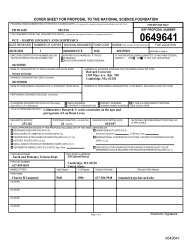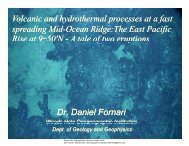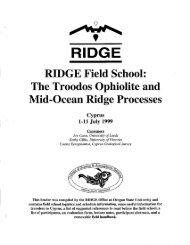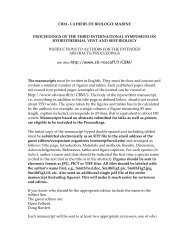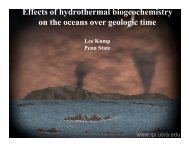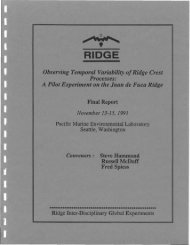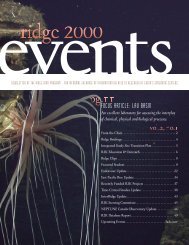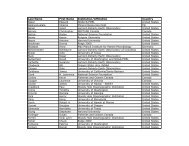Create successful ePaper yourself
Turn your PDF publications into a flip-book with our unique Google optimized e-Paper software.
Strategies For Solving The Critical Problems<br />
We envision a strategy with four major components.<br />
1. Global Reconnaissance. The first component would<br />
include reconnaissance studies of substantial lengths of the<br />
mid-ocean ridge system in order to obtain a measure of the world<br />
wide variability of ocean ridge morphologic, structural and<br />
chemical characteristics. The reonnaissance would include<br />
bathymetric surveys over a distance of approximately 1000 km<br />
continuously along the strike of the ridge, with a swath width<br />
of several times the active accretion zone; multichannel seismiC<br />
(MCS) surveys along the axis to define the lateral continuity<br />
and width of the axial low velocity zone and any variations in<br />
seismically estimated crustal thickness; petrological sampling<br />
with approximately one station for every 10 to 20 km of ridge<br />
length, in order to determine the regional geochemical signature<br />
and to explore quantitative relationships among petrology,<br />
bathymetry, and the MCS axial reflector, and continuous<br />
surveying of along-axis water column temperature and chemical<br />
anomalies, in order to determine the distribution of<br />
hydrothermal activity. Such reconnaissance surveys should cover<br />
ridges which vary in their spreading rate, in their tectonic<br />
style (i .e., fracture zone spacing, presence or absence of rift<br />
valley, back-arc settings L and in the ambient mantle<br />
temperature (i.e., hot spots such as Ic.:land and cold spots such<br />
as the Australian!Antarctic Discordance). Approximately ten<br />
such surveys will be necessary to obtain adequate global<br />
coverage. These surveys will lead to coverage of about<br />
20 percent of the entire system of ocean ridges. They will<br />
determine the global distribution of magma chambers and provide<br />
the data necessary to develop quantitative relationships among<br />
spreading rate, gross tectonic fabric, magma chambers and<br />
geochemistry.<br />
2. Eruption Detection. The second component stems from<br />
the recognition that the ocean ridge volcano observatory should<br />
be located in an area of active volcanism. To find such a<br />
location we need to know the periodicity in space and time of<br />
volcanic eruptions on the sea floor, and the relationship of<br />
such eruptions to hydrothermal activity. There is at the moment<br />
no such information for submarine ocean ridges. Calculation of<br />
magma production rates and analogy with terrestrial volcanos<br />
suggests we should be able to find an active volcanic area which<br />
would remain active on the time scale of a decade. To find such<br />
a location, however, requires effective eruption monitoring.<br />
Two approaches could be explored: (a) long term monitoring of<br />
hydrothermal plumes and (b) acoustic monitoring. In addition to<br />
locating active ridge segments, such monitoring will provide<br />
data concerning regional eruption frequency and spatial<br />
systematics.<br />
24




